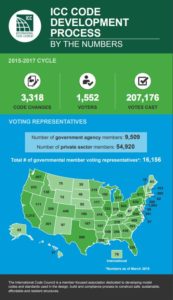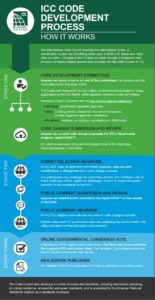
Five big takeaways from the Committee Action Hearings
The 2018 Committee Action Hearings took place April 15–23, 2018, in Columbus, Ohio, to consider proposed changes to the Group A International Codes. The first in the 2021 code development cycle, the hearings saw action on more than 1,300 comments and nearly 100 hours of testimony during the 10 days in Columbus. The April hearings are the first chance to publicly review proposed code changes and provide feedback for the 2021 International Codes.
The International Codes are a family of 15 coordinated, modern building safety codes used throughout the world that protect against disasters like fires, weather-related events and structural collapse. The Group A Codes considered in Columbus include the International Building Code (egress, fire safety, general); International Fire Code; International Fuel Gas Code; International Mechanical Code; International Plumbing Code; International Property Maintenance Code; International Private Sewage Disposal Code; International Residential Code (mechanical, plumbing); International Swimming Pool and Spa Code; International Wildland-Urban Interface Code; and International Zoning Code.
Here are five of the biggest takeaways from the 2018 Committee Action Hearings.
Tall wood buildings
Fourteen code changes introduced three new types of heavy timber (Type IV) and corresponding increases in allowable heights and area. As approved at the Committee Action Hearings, certain occupancies have an allowable height of 18 stories, which exceeds the current limitation of six stories. Many of the code changes provide additional details to ensure both the structural and fire resistance integrity of taller mass timber buildings. All 14 code changes were approved.
Exterior walls
Numerous code changes submitted to address the fire safety attributes of exterior walls, including cladding. One of the proposals was approved to re-organize the provisions. The majority of the other proposals were disapproved but it is highly likely that many will received public comments and will therefore be considered at the Public Comment Hearing in Richmond in the fall. Of particular interest, a proposal was approved that removed what were allowances for metal composite materials (MCM) to be unlimited in height without more rigorous testing. Typically MCM is installed with other materials such as foam insulation that would still require such testing regardless of these allowances.
Fire safety during construction
Code change F263 was approved which requires that the owner of the construction project designate a fire prevention program superintendent who is responsible for performing daily fire inspections at the construction site. In addition, F264, which was approved, clarified the role and training requirements for fire watch personnel and now requires a fire watch both when the construction exceeds 40 feet above lowest grade and for multi-story buildings where any story exceeds 50,000 feet. Previously, it was based upon height alone. Approved proposal F268 addresses minimum fire flows for construction sites for Type III, IV and V construction.
A2L and B2L refrigerants
A group of code changes were submitted to address flammability considerations of A2L and B2L refrigerants used for human comfort. These new types of refrigerants include the significant benefit on the environment as they are intended to reduce the global warming potential of refrigerants on the atmosphere. These were disapproved primarily due to the fact that the applicable ASHRAE standards are currently being updated, and the updates have not been completed.
Gender neutral multi-user toilet facilities
Four proposals were submitted to address multi-user toilet facilities designed to serve all genders. Two were successful. Historically, the International Plumbing Code has always required multi-user toilet facilities to be identified by sex — that is, having either a male designation or a female designation on the door or entry way to the facility. A greater societal focus on inclusiveness and equality for persons whose gender identity does not match their sex is promoting code allowances for the design of multi-user toilet facilities that are not designated for either sex. Such facilities could be identified by any inclusive gender signage or by no signage, or by simply “Toilets” or “Restroom”.
The next phase
As we prepare to move into the next phase of the 2018/2019 code development cycle, here are some dates and information to keep in mind.
- The official Committee Action Hearing results on the 2018 proposed changes to the Group A International Codes are available online.
- The online assembly motion vote for the Group A International Codes, which starts approximately two weeks after the last day of the Committee Action Hearing, opened on May 9. Online voting through cdpACCESS is open on 17 assembly floor motions. It will close at 2:00 a.m. PT on May 23, 2018.
- A comprehensive report of Committee Action Hearing actions is scheduled to be posted on May 30, 2018, in the Report of the Committee Action Hearing. This will indicate the action taken by the committee and their reasons, approved modifications, the results of the Online Committee Action Hearing Assembly Floor Motion Vote and any errata to the text of the code change proposals.
- The deadline for receipt of public comments is July 16, 2018. All public comments must be submitted online via cdpACCESS.
- The submittal of public comments will be considered at the 2018 Group A Public Comment Hearings scheduled for Oct. 24–31, 2018, in Richmond, Va.
The International Code Council’s code development process for the 2021 codes will take three years and is open, transparent and inclusive. To learn the basics of the code development process, check out our video, which is a good primer for those new to the process and explains ICC’s cloud-based system for the code development process — cdpACCESS — in terms everyone can understand.
For more information about the code development process, click here.
Download infographics about the process: How It Works and By the Numbers.


Click here to see photos from the 2018 Committee Action Hearings in Columbus.






